Ferguson
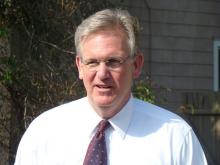
Missouri Gov. Jay Nixon signed an executive action this afternoon declaring a state of emergency in Missouri and activating the National Guard to respond to “any period of unrest that might occur following the grand jury’s decision concerning the investigation into the death of Michael Brown.”
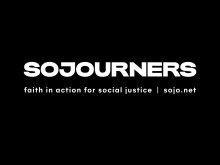

What do you see when you look at this picture?
In essence, that is the question St. Louis Prosecuting Attorney Robert McCulloch asked the grand jury to determine in his case against Officer Darren Wilson, who shot and killed unarmed 18-year-old Michael Brown on Aug. 9 in Ferguson, Mo.
According to an early report in TIME, McCulloch made an unusual move: He did not specify a specific charge for Wilson.
In a recent phone interview, Denise Lieberman, co-chair of the Don’t Shoot Coalition and senior attorney for the Advancement Project, explained to me: “Grand jury proceedings occur in private, so we don’t know exactly what’s been said … However, we’ve been told that the prosecutor is not making a recommendation to the jury about whether to indict and what charges … That is fairly unusual, if in fact that is true.”
Rather than specifying charges, two senior attorneys in his office are presenting all the evidence as it becomes available and letting the grand jury decide what charge(s), if any, that evidence warrants. McCulloch’s office claimed this process is fair because the grand jury, which is representative of the community of St. Louis, is able to see all of the evidence and then offer its decision.
According to Ed Magee, a spokesperson from McCulloch’s office, grand juries usually only review a few pieces of evidence. “Normally they hear from a detective or a main witness or two. That’s it,” Magee said in an early September interview with the Washington Post.
By presenting all the evidence to laypeople, reportedly without legal interpretation, McCulloch is basically raising a proverbial Rorschach to the grand jury and saying, “see what you see.” That is not a passive act in a society where 75 percent of people tested display some measure of unconscious racial bias.
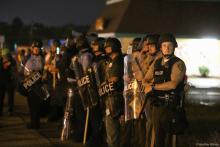
An imminent grand jury verdict in St. Louis County will determine whether to indict Ferguson police office Darren Wilson on criminal charges for shooting Michael Brown. News reports have detailed the expectation of violence in the St. Louis area after the decision is handed down and the mobilization being planned by law enforcement in response. This is an open letter to Missouri Gov. Jay Nixon urging him to maintain peace and protect those exercising their right to free speech. I encourage you to read the letter and join me and others across the country in signing it now. Your voice can make a difference. Sojourners will send the letter and signatures to the Gov. Nixon. – Jim Wallis, Sojourners
Dear Gov. Nixon,
For the last several months, the nation’s eyes have been on Ferguson, Mo. Few had heard of this small St. Louis suburb until Michael Brown was shot and killed by a member of the city’s police department — whose mission is supposedly to serve and protect. Now this community is an infamous global symbol of the nation’s continued struggle for racial equality and the troubling trend of police militarization.
Jesus proclaimed, “Blessed are the peacemakers for they shall be called the children of God” (Matthew 5:9). The Rev. Dr. Martin Luther King Jr. reminded us, “True peace is not merely the absence of tension: it is the presence of justice.” These are not idealistic thoughts or nice sentiments to be dismissed when tensions and conflict arise. Rather, they are wise words of truth that should guide our thinking in moments of distress. We need to make Jesus’ instruction real and consider Dr. King’s words a practical exhortation for the ensuring peace and public safety in Ferguson once the grand jury has made the decision of whether to indict Darren Wilson.
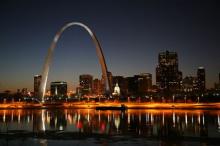
Some might argue that if there is one thing this city could use more of right now, it’s compassion.
Even before civil unrest surfaced in the region after Officer Darren Wilson killed Michael Brown in Ferguson, local leaders were trying to find a way to cultivate more of it. But how exactly? And how would we know when we had enough?
Unlike other commodities, compassion is difficult to quantify.
But that hasn’t stopped the formation of a worldwide movement for compassionate cities. St. Louis is the latest municipality to vie to be part of the sympathetic pack, which includes Louisville, Ky.; Atlanta; Nashville, Tenn.; Seattle; and other cities from around the world.
On Nov. 13, in an effort to bring St. Louis one step closer to officially signing on to what noted religion scholar Karen Armstrong coined as the Charter for Compassion, advocates will host the first-ever town hall meeting dedicated to the crusade.
“We’re wired for compassion and what we would hope for and work toward is compassionate energy and action becoming an increasing factor in decision making and planning across the St. Louis region,” said David Mehl of the Interfaith Partnership of Greater St. Louis, a key member of a group of about 30 local leaders pushing that the city, like others around the nation, agree to the charter’s terms.
“The situation in Ferguson and beyond makes this all the more relevant.”


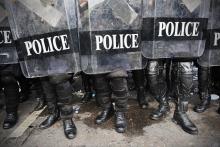
AS A FORMER reserve police officer who has taught ethics at two police academies, I followed the news very closely after 18-year-old Michael Brown was shot to death by police officer Darren Wilson in nearby Ferguson, Mo. When I saw the military equipment of the St. Louis County Police—especially the sharpshooter on top of an armored vehicle aiming his rifle at the protesters—I said to my wife, “This may turn out to be very, very bad.”
Sen. Claire McCaskill argued in the midst of the protests that St. Louis County should “demilitarize the police response” in Ferguson, telling reporters, “The police response has been part of the problem.”
The militarization of police has been trending over the past few decades. When the thin blue line resembles an occupying force, it exacerbates racial tensions in neighborhoods and communities, making things worse for everyone, including the police.
Some communities are starting to push back. For instance, the city council of Davis, Calif., recently directed its police department to get rid of a mine-resistant, ambush-protected vehicle (worth $700,000) that it had received free from the U.S. military’s surplus program.

WHEN JOHANNES BRAHMS first played his German Requiem in Vienna in 1867, the audience was shocked. In fact, scholars report that some “hissed and booed and behaved quite boorishly.”
This October, when the St. Louis Symphony performed the same piece along with German composer Detlev Glanert’s arrangement of Brahms’ Four Preludes and Serious Songs, it elicited a similar response.
Not to the work itself, but to what occurred during intermission.
As conductor Markus Stenz took the stage, two audience members began to sing. In strong, clear voices, they performed Florence Patton Reece’s famous justice hymn: “Which side are you on, friend? Which side are you on?” Nearly a dozen more scattered throughout Powell Hall joined in. While the audience watched in stunned silence, a banner unfurled from the balcony with a silhouette of a man’s face. It said: Requiem for Mike Brown 1996-2014.
As in Vienna, there were some boos from the audience and a few expletives—more disruption following the Aug. 9 shooting death of Michael Brown, an unarmed African-American teenager, by white police officer Darren Wilson. While the Vienna audience complained that Brahms’ music was too religious for a secular setting, one St. Louis symphony-goer asked, “Is Powell Hall a proper venue for a protest?” And a Catholic priest challenged: “Instead of chanting ‘Which side are you on?’ further dividing the community, try singing ‘How can we heal?’”
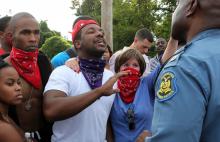
The first time the public heard the name Renita Lamkin was probably the day she was shot.
In early August, four days after Michael Brown was killed by Officer Darren Wilson, Lamkin, a pastor, stood with Ferguson protesters, attempting to mediate. Police had warned the crowd to disperse and in an effort to buy a little time, Lamkin shouted, “They’re leaving!”
“That’s when I felt a pop in the stomach,” Lamkin said of the rubber pellet that hit her. The pellet left a ghastly wound — large, deep and purplish — and created a social media frenzy.
Tweet after tweet showed Lamkin, 44 and white, wearing a T-shirt with an image of a cross that she lifted up just slightly to show off the ugly bruise.
Lamkin said she didn’t really have a plan when she ventured out to Ferguson but that “the whole being shot thing was probably the best thing that could have happened.” The injury had cemented Lamkin’s role in the struggle for racial equality.
“They say, ‘You took a bullet for us.’ My sense is …We’re in this together, and I was playing my role,” Lamkin said.




Ryan Herring reads Langston Hughes' "Harlem" as photos of Ferguson are displayed.



